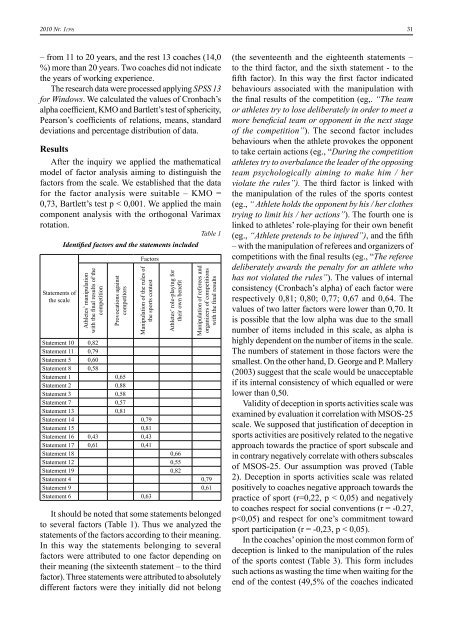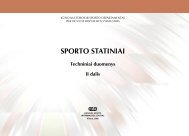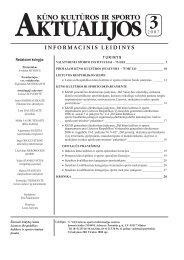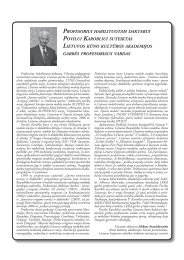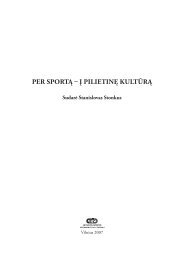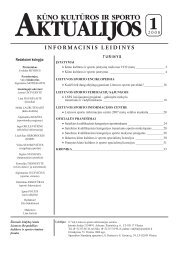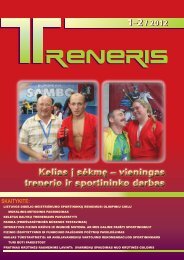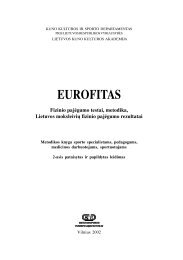Nr. 1 - Lietuvos sporto informacijos centras
Nr. 1 - Lietuvos sporto informacijos centras
Nr. 1 - Lietuvos sporto informacijos centras
Create successful ePaper yourself
Turn your PDF publications into a flip-book with our unique Google optimized e-Paper software.
2010 <strong>Nr</strong>. 1(59)<br />
31<br />
– from 11 to 20 years, and the rest 13 coaches (14,0<br />
%) more than 20 years. Two coaches did not indicate<br />
the years of working experience.<br />
The research data were processed applying SPSS 13<br />
for Windows. We calculated the values of Cronbach’s<br />
alpha coefficient, KMO and Bartlett’s test of sphericity,<br />
Pearson’s coefficients of relations, means, standard<br />
deviations and percentage distribution of data.<br />
Results<br />
After the inquiry we applied the mathematical<br />
model of factor analysis aiming to distinguish the<br />
factors from the scale. We established that the data<br />
for the factor analysis were suitable – KMO =<br />
0,73, Bartlett’s test p < 0,001. We applied the main<br />
component analysis with the orthogonal Varimax<br />
rotation.<br />
Table 1<br />
Identified factors and the statements included<br />
Statements of<br />
the scale<br />
Athletes’ manipulation<br />
with the final results of the<br />
competition<br />
Provocations against<br />
competitors<br />
Factors<br />
Manipulation of the rules of<br />
the sports contest<br />
Athletes’ role-playing for<br />
their own benefit<br />
Manipulation of referees and<br />
organizers of competitions<br />
with the final results<br />
Statement 10 0,82<br />
Statement 11 0,79<br />
Statement 5 0,60<br />
Statement 8 0,58<br />
Statement 1 0,65<br />
Statement 2 0,88<br />
Statement 3 0,58<br />
Statement 7 0,57<br />
Statement 13 0,81<br />
Statement 14 0,79<br />
Statement 15 0,81<br />
Statement 16 0,43 0,43<br />
Statement 17 0,61 0,41<br />
Statement 18 0,66<br />
Statement 12 0,55<br />
Statement 19 0,82<br />
Statement 4 0,79<br />
Statement 9 0,61<br />
Statement 6 0,63<br />
It should be noted that some statements belonged<br />
to several factors (Table 1). Thus we analyzed the<br />
statements of the factors according to their meaning.<br />
In this way the statements belonging to several<br />
factors were attributed to one factor depending on<br />
their meaning (the sixteenth statement – to the third<br />
factor). Three statements were attributed to absolutely<br />
different factors were they initially did not belong<br />
(the seventeenth and the eighteenth statements –<br />
to the third factor, and the sixth statement - to the<br />
fifth factor). In this way the first factor indicated<br />
behaviours associated with the manipulation with<br />
the final results of the competition (eg,. “The team<br />
or athletes try to lose deliberately in order to meet a<br />
more beneficial team or opponent in the next stage<br />
of the competition”). The second factor includes<br />
behaviours when the athlete provokes the opponent<br />
to take certain actions (eg., “During the competition<br />
athletes try to overbalance the leader of the opposing<br />
team psychologically aiming to make him / her<br />
violate the rules”). The third factor is linked with<br />
the manipulation of the rules of the sports contest<br />
(eg., “ Athlete holds the opponent by his / her clothes<br />
trying to limit his / her actions”). The fourth one is<br />
linked to athletes’ role-playing for their own benefit<br />
(eg., “Athlete pretends to be injured”), and the fifth<br />
– with the manipulation of referees and organizers of<br />
competitions with the final results (eg., “The referee<br />
deliberately awards the penalty for an athlete who<br />
has not violated the rules”). The values of internal<br />
consistency (Cronbach’s alpha) of each factor were<br />
respectively 0,81; 0,80; 0,77; 0,67 and 0,64. The<br />
values of two latter factors were lower than 0,70. It<br />
is possible that the low alpha was due to the small<br />
number of items included in this scale, as alpha is<br />
highly dependent on the number of items in the scale.<br />
The numbers of statement in those factors were the<br />
smallest. On the other hand, D. George and P. Mallery<br />
(2003) suggest that the scale would be unacceptable<br />
if its internal consistency of which equalled or were<br />
lower than 0,50.<br />
Validity of deception in sports activities scale was<br />
examined by evaluation it correlation with MSOS‐25<br />
scale. We supposed that justification of deception in<br />
sports activities are positively related to the negative<br />
approach towards the practice of sport subscale and<br />
in contrary negatively correlate with others subscales<br />
of MSOS‐25. Our assumption was proved (Table<br />
2). Deception in sports activities scale was related<br />
positively to coaches negative approach towards the<br />
practice of sport (r=0,22, p < 0,05) and negatively<br />
to coaches respect for social conventions (r = ‐0.27,<br />
p


